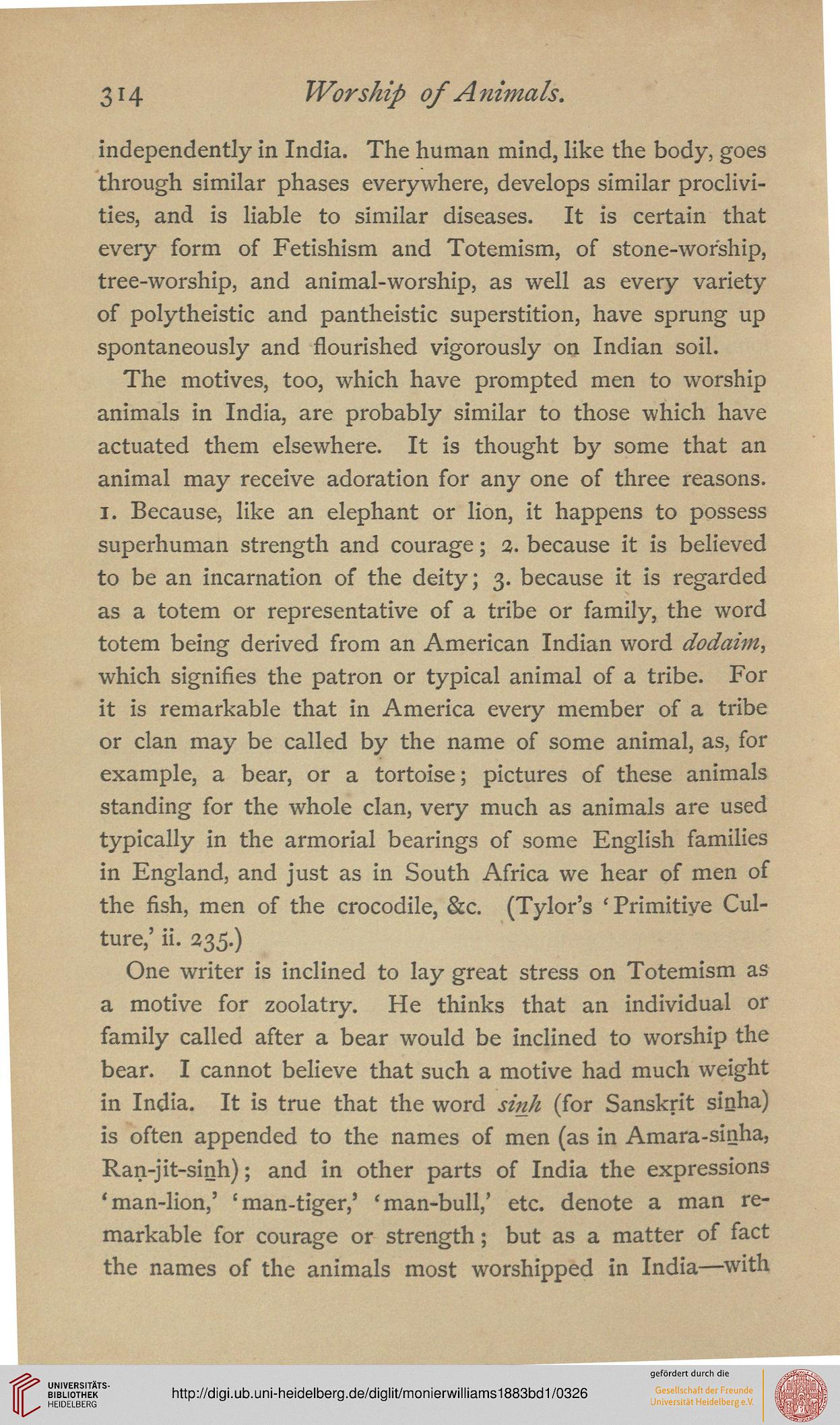314
Worship of Animals.
independently in India. The human mind, like the body, goes
through similar phases everywhere, develops similar proclivi-
ties, and is liable to similar diseases. It is certain that
every form of Fetishism and Totemism, of stone-worship,
tree-worship, and animal-worship, as well as every variety
of polytheistic and pantheistic superstition, have sprung up
spontaneously and flourished vigorously on Indian soil.
The motives, too, which have prompted men to worship
animals in India, are probably similar to those which have
actuated them elsewhere. It is thought by some that an
animal may receive adoration for any one of three reasons.
i. Because, like an elephant or lion, it happens to possess
superhuman strength and courage; a. because it is believed
to be an incarnation of the deity; 3. because it is regarded
as a totem or representative of a tribe or family, the word
totem being derived from an American Indian word dodaim,
which signifies the patron or typical animal of a tribe. For
it is remarkable that in America every member of a tribe
or clan may be called by the name of some animal, as, for
example, a bear, or a tortoise; pictures of these animals
standing for the whole clan, very much as animals are used
typically in the armorial bearings of some English families
in England, and just as in South Africa we hear of men of
the fish, men of the crocodile, &c. (Tylor's 'Primitive Cul-
ture,' ii. 235.)
One writer is inclined to lay great stress on Totemism as
a motive for zoolatry. He thinks that an individual or
family called after a bear would be inclined to worship the
bear. I cannot believe that such a motive had much weight
in India. It is true that the word sink (for Sanskrit sinha)
is often appended to the names of men (as in Amara-sinha,
Ran-jit-sinh); and in other parts of India the expressions
'man-lion,' 'man-tiger,' 'man-bull,' etc. denote a man re-
markable for courage or strength; but as a matter of fact
the names of the animals most worshipped in India—with
Worship of Animals.
independently in India. The human mind, like the body, goes
through similar phases everywhere, develops similar proclivi-
ties, and is liable to similar diseases. It is certain that
every form of Fetishism and Totemism, of stone-worship,
tree-worship, and animal-worship, as well as every variety
of polytheistic and pantheistic superstition, have sprung up
spontaneously and flourished vigorously on Indian soil.
The motives, too, which have prompted men to worship
animals in India, are probably similar to those which have
actuated them elsewhere. It is thought by some that an
animal may receive adoration for any one of three reasons.
i. Because, like an elephant or lion, it happens to possess
superhuman strength and courage; a. because it is believed
to be an incarnation of the deity; 3. because it is regarded
as a totem or representative of a tribe or family, the word
totem being derived from an American Indian word dodaim,
which signifies the patron or typical animal of a tribe. For
it is remarkable that in America every member of a tribe
or clan may be called by the name of some animal, as, for
example, a bear, or a tortoise; pictures of these animals
standing for the whole clan, very much as animals are used
typically in the armorial bearings of some English families
in England, and just as in South Africa we hear of men of
the fish, men of the crocodile, &c. (Tylor's 'Primitive Cul-
ture,' ii. 235.)
One writer is inclined to lay great stress on Totemism as
a motive for zoolatry. He thinks that an individual or
family called after a bear would be inclined to worship the
bear. I cannot believe that such a motive had much weight
in India. It is true that the word sink (for Sanskrit sinha)
is often appended to the names of men (as in Amara-sinha,
Ran-jit-sinh); and in other parts of India the expressions
'man-lion,' 'man-tiger,' 'man-bull,' etc. denote a man re-
markable for courage or strength; but as a matter of fact
the names of the animals most worshipped in India—with




